BTEC Unit 6: Project Analyzing Equality and Diversity at Sainsbury's
VerifiedAdded on 2023/01/06
|23
|5187
|1
Report
AI Summary
This report presents a comprehensive analysis of a business project conducted on equality and diversity within Sainsbury's. The project aims to identify the impact of the gender pay gap on employee productivity. The report includes a detailed introduction defining equality and diversity, followed by an overview of the research aim, objectives, and research questions. It reviews relevant literature on equality and diversity, the effects of gender pay gaps, and measures to address these issues. The project management plan outlines costs, scope, quality, communication, and risk management. A work breakdown structure (WBS) and Gantt chart are used to organize the project activities. The research employs both primary and secondary methods, including questionnaires for data collection. Data interpretation and analysis of the findings are presented, followed by recommendations. Finally, the report concludes with a reflection on the project's value and its usefulness in supporting sustainable organizational performance. The report is designed to fulfill the requirements of Unit 6 Managing a Successful Business Project at the London College of Contemporary Arts.

UNIT 6 Managing A
Successful Business
Project
Successful Business
Project
Paraphrase This Document
Need a fresh take? Get an instant paraphrase of this document with our AI Paraphraser
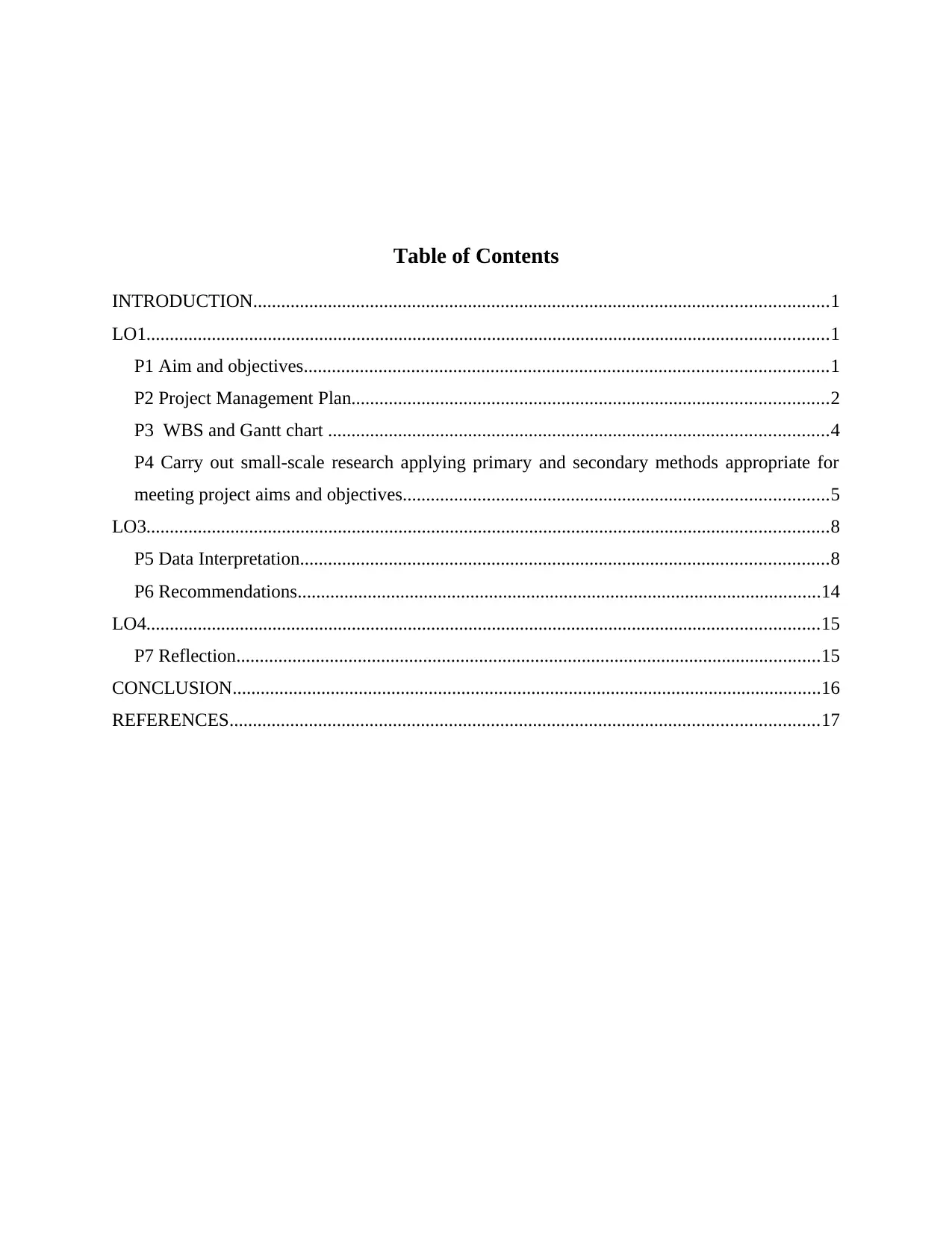
Table of Contents
INTRODUCTION...........................................................................................................................1
LO1..................................................................................................................................................1
P1 Aim and objectives................................................................................................................1
P2 Project Management Plan......................................................................................................2
P3 WBS and Gantt chart ...........................................................................................................4
P4 Carry out small-scale research applying primary and secondary methods appropriate for
meeting project aims and objectives...........................................................................................5
LO3..................................................................................................................................................8
P5 Data Interpretation.................................................................................................................8
P6 Recommendations................................................................................................................14
LO4................................................................................................................................................15
P7 Reflection.............................................................................................................................15
CONCLUSION..............................................................................................................................16
REFERENCES..............................................................................................................................17
INTRODUCTION...........................................................................................................................1
LO1..................................................................................................................................................1
P1 Aim and objectives................................................................................................................1
P2 Project Management Plan......................................................................................................2
P3 WBS and Gantt chart ...........................................................................................................4
P4 Carry out small-scale research applying primary and secondary methods appropriate for
meeting project aims and objectives...........................................................................................5
LO3..................................................................................................................................................8
P5 Data Interpretation.................................................................................................................8
P6 Recommendations................................................................................................................14
LO4................................................................................................................................................15
P7 Reflection.............................................................................................................................15
CONCLUSION..............................................................................................................................16
REFERENCES..............................................................................................................................17
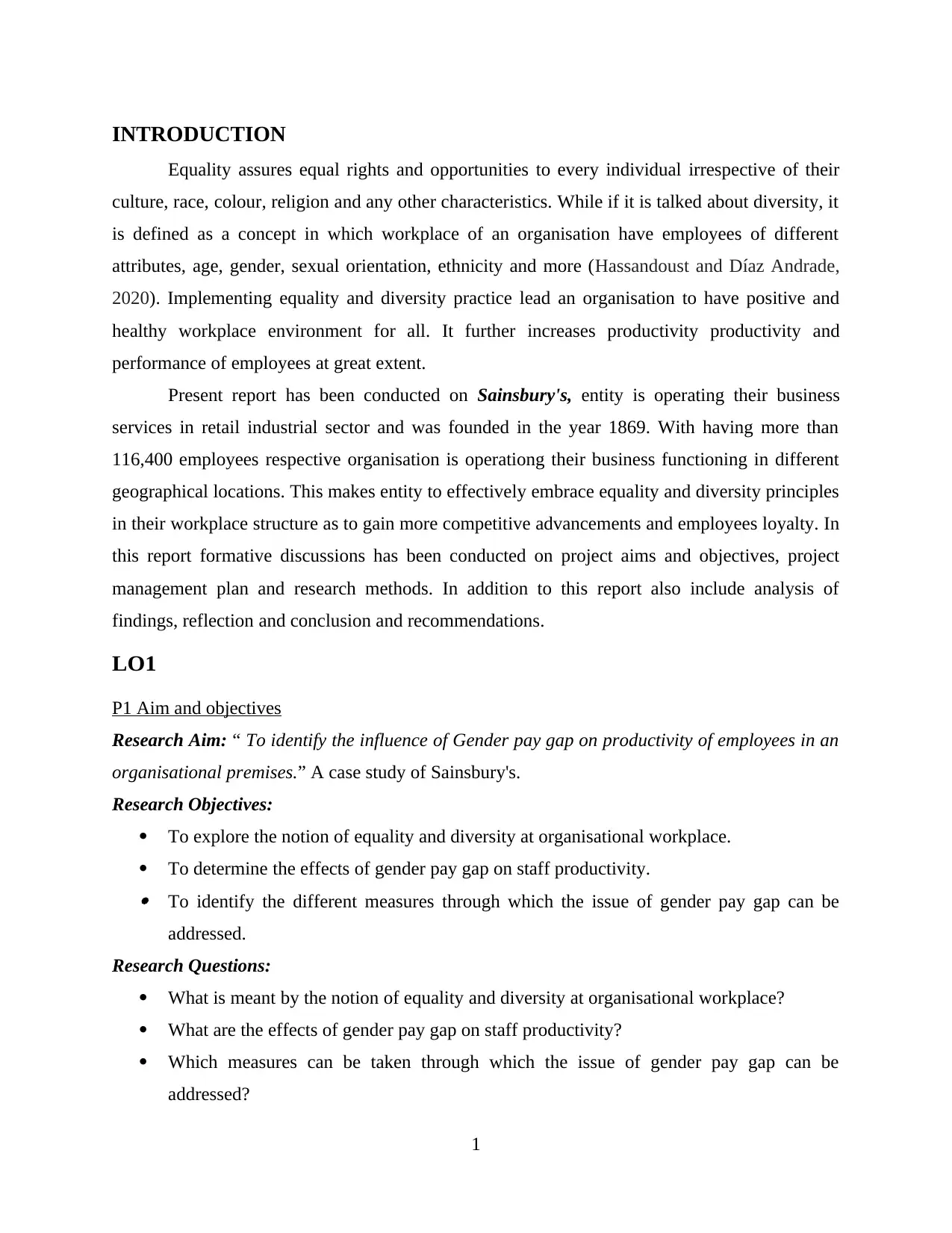
INTRODUCTION
Equality assures equal rights and opportunities to every individual irrespective of their
culture, race, colour, religion and any other characteristics. While if it is talked about diversity, it
is defined as a concept in which workplace of an organisation have employees of different
attributes, age, gender, sexual orientation, ethnicity and more (Hassandoust and Díaz Andrade,
2020). Implementing equality and diversity practice lead an organisation to have positive and
healthy workplace environment for all. It further increases productivity productivity and
performance of employees at great extent.
Present report has been conducted on Sainsbury's, entity is operating their business
services in retail industrial sector and was founded in the year 1869. With having more than
116,400 employees respective organisation is operationg their business functioning in different
geographical locations. This makes entity to effectively embrace equality and diversity principles
in their workplace structure as to gain more competitive advancements and employees loyalty. In
this report formative discussions has been conducted on project aims and objectives, project
management plan and research methods. In addition to this report also include analysis of
findings, reflection and conclusion and recommendations.
LO1
P1 Aim and objectives
Research Aim: “ To identify the influence of Gender pay gap on productivity of employees in an
organisational premises.” A case study of Sainsbury's.
Research Objectives:
To explore the notion of equality and diversity at organisational workplace.
To determine the effects of gender pay gap on staff productivity. To identify the different measures through which the issue of gender pay gap can be
addressed.
Research Questions:
What is meant by the notion of equality and diversity at organisational workplace?
What are the effects of gender pay gap on staff productivity?
Which measures can be taken through which the issue of gender pay gap can be
addressed?
1
Equality assures equal rights and opportunities to every individual irrespective of their
culture, race, colour, religion and any other characteristics. While if it is talked about diversity, it
is defined as a concept in which workplace of an organisation have employees of different
attributes, age, gender, sexual orientation, ethnicity and more (Hassandoust and Díaz Andrade,
2020). Implementing equality and diversity practice lead an organisation to have positive and
healthy workplace environment for all. It further increases productivity productivity and
performance of employees at great extent.
Present report has been conducted on Sainsbury's, entity is operating their business
services in retail industrial sector and was founded in the year 1869. With having more than
116,400 employees respective organisation is operationg their business functioning in different
geographical locations. This makes entity to effectively embrace equality and diversity principles
in their workplace structure as to gain more competitive advancements and employees loyalty. In
this report formative discussions has been conducted on project aims and objectives, project
management plan and research methods. In addition to this report also include analysis of
findings, reflection and conclusion and recommendations.
LO1
P1 Aim and objectives
Research Aim: “ To identify the influence of Gender pay gap on productivity of employees in an
organisational premises.” A case study of Sainsbury's.
Research Objectives:
To explore the notion of equality and diversity at organisational workplace.
To determine the effects of gender pay gap on staff productivity. To identify the different measures through which the issue of gender pay gap can be
addressed.
Research Questions:
What is meant by the notion of equality and diversity at organisational workplace?
What are the effects of gender pay gap on staff productivity?
Which measures can be taken through which the issue of gender pay gap can be
addressed?
1
⊘ This is a preview!⊘
Do you want full access?
Subscribe today to unlock all pages.

Trusted by 1+ million students worldwide
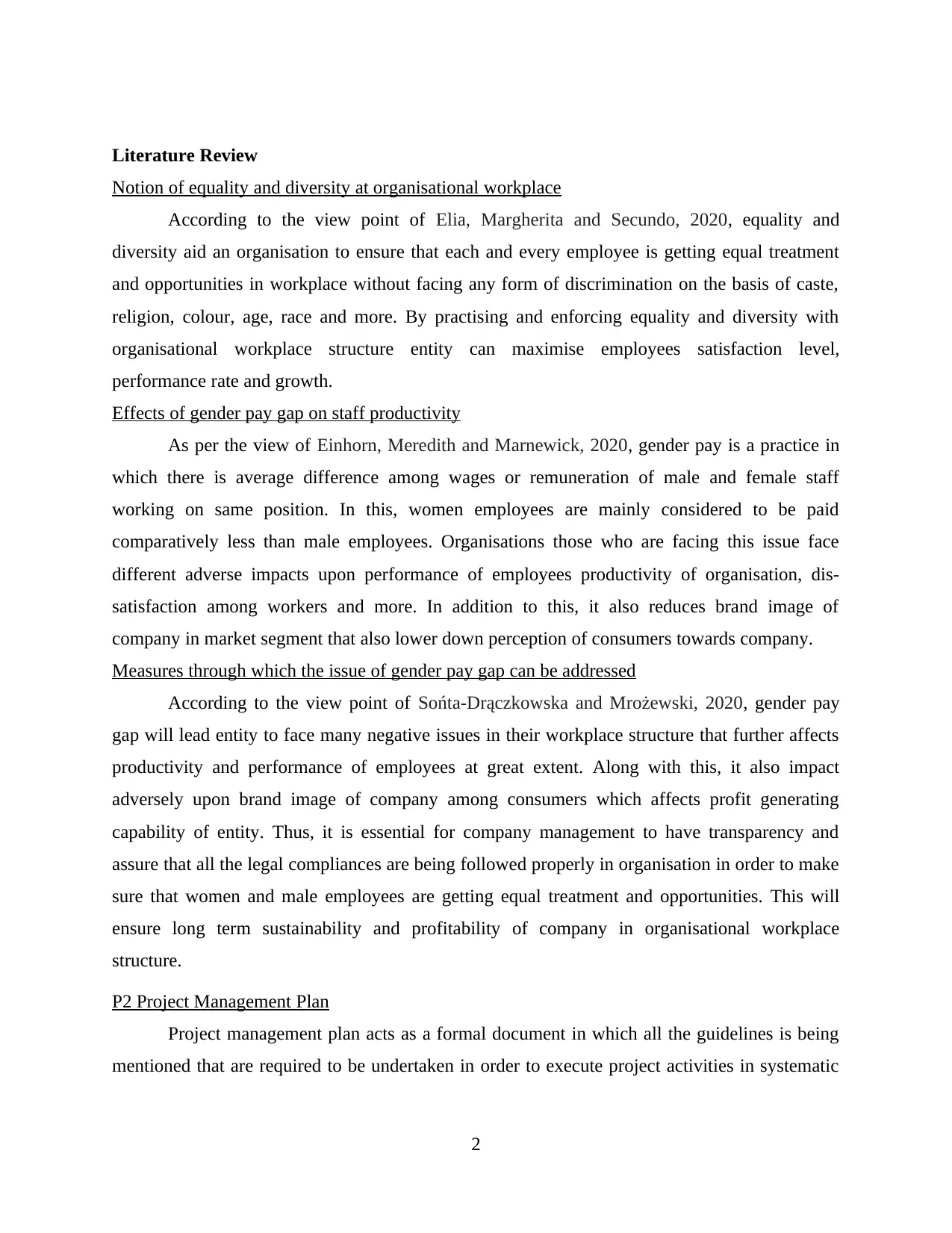
Literature Review
Notion of equality and diversity at organisational workplace
According to the view point of Elia, Margherita and Secundo, 2020, equality and
diversity aid an organisation to ensure that each and every employee is getting equal treatment
and opportunities in workplace without facing any form of discrimination on the basis of caste,
religion, colour, age, race and more. By practising and enforcing equality and diversity with
organisational workplace structure entity can maximise employees satisfaction level,
performance rate and growth.
Effects of gender pay gap on staff productivity
As per the view of Einhorn, Meredith and Marnewick, 2020, gender pay is a practice in
which there is average difference among wages or remuneration of male and female staff
working on same position. In this, women employees are mainly considered to be paid
comparatively less than male employees. Organisations those who are facing this issue face
different adverse impacts upon performance of employees productivity of organisation, dis-
satisfaction among workers and more. In addition to this, it also reduces brand image of
company in market segment that also lower down perception of consumers towards company.
Measures through which the issue of gender pay gap can be addressed
According to the view point of Sońta-Drączkowska and Mrożewski, 2020, gender pay
gap will lead entity to face many negative issues in their workplace structure that further affects
productivity and performance of employees at great extent. Along with this, it also impact
adversely upon brand image of company among consumers which affects profit generating
capability of entity. Thus, it is essential for company management to have transparency and
assure that all the legal compliances are being followed properly in organisation in order to make
sure that women and male employees are getting equal treatment and opportunities. This will
ensure long term sustainability and profitability of company in organisational workplace
structure.
P2 Project Management Plan
Project management plan acts as a formal document in which all the guidelines is being
mentioned that are required to be undertaken in order to execute project activities in systematic
2
Notion of equality and diversity at organisational workplace
According to the view point of Elia, Margherita and Secundo, 2020, equality and
diversity aid an organisation to ensure that each and every employee is getting equal treatment
and opportunities in workplace without facing any form of discrimination on the basis of caste,
religion, colour, age, race and more. By practising and enforcing equality and diversity with
organisational workplace structure entity can maximise employees satisfaction level,
performance rate and growth.
Effects of gender pay gap on staff productivity
As per the view of Einhorn, Meredith and Marnewick, 2020, gender pay is a practice in
which there is average difference among wages or remuneration of male and female staff
working on same position. In this, women employees are mainly considered to be paid
comparatively less than male employees. Organisations those who are facing this issue face
different adverse impacts upon performance of employees productivity of organisation, dis-
satisfaction among workers and more. In addition to this, it also reduces brand image of
company in market segment that also lower down perception of consumers towards company.
Measures through which the issue of gender pay gap can be addressed
According to the view point of Sońta-Drączkowska and Mrożewski, 2020, gender pay
gap will lead entity to face many negative issues in their workplace structure that further affects
productivity and performance of employees at great extent. Along with this, it also impact
adversely upon brand image of company among consumers which affects profit generating
capability of entity. Thus, it is essential for company management to have transparency and
assure that all the legal compliances are being followed properly in organisation in order to make
sure that women and male employees are getting equal treatment and opportunities. This will
ensure long term sustainability and profitability of company in organisational workplace
structure.
P2 Project Management Plan
Project management plan acts as a formal document in which all the guidelines is being
mentioned that are required to be undertaken in order to execute project activities in systematic
2
Paraphrase This Document
Need a fresh take? Get an instant paraphrase of this document with our AI Paraphraser
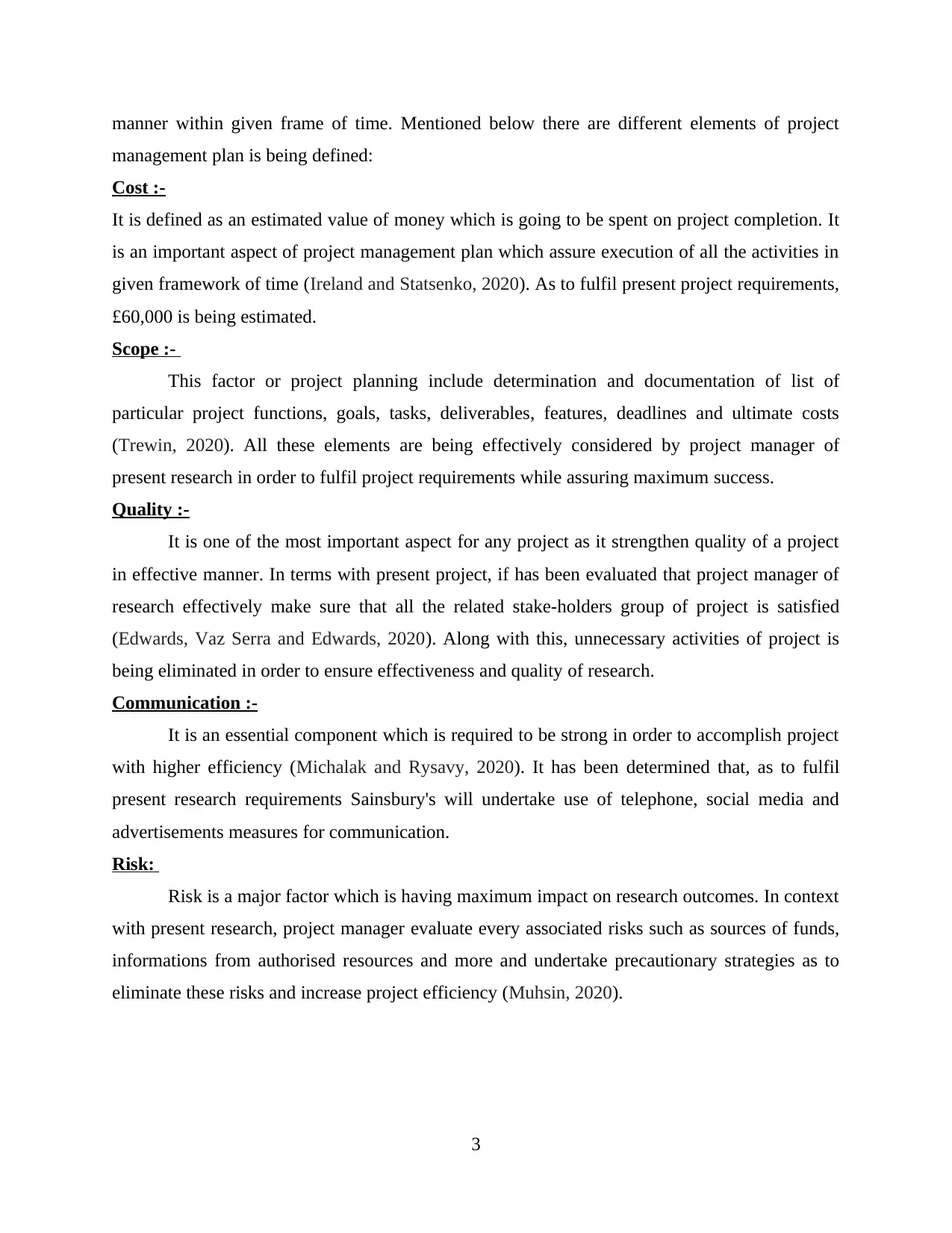
manner within given frame of time. Mentioned below there are different elements of project
management plan is being defined:
Cost :-
It is defined as an estimated value of money which is going to be spent on project completion. It
is an important aspect of project management plan which assure execution of all the activities in
given framework of time (Ireland and Statsenko, 2020). As to fulfil present project requirements,
£60,000 is being estimated.
Scope :-
This factor or project planning include determination and documentation of list of
particular project functions, goals, tasks, deliverables, features, deadlines and ultimate costs
(Trewin, 2020). All these elements are being effectively considered by project manager of
present research in order to fulfil project requirements while assuring maximum success.
Quality :-
It is one of the most important aspect for any project as it strengthen quality of a project
in effective manner. In terms with present project, if has been evaluated that project manager of
research effectively make sure that all the related stake-holders group of project is satisfied
(Edwards, Vaz Serra and Edwards, 2020). Along with this, unnecessary activities of project is
being eliminated in order to ensure effectiveness and quality of research.
Communication :-
It is an essential component which is required to be strong in order to accomplish project
with higher efficiency (Michalak and Rysavy, 2020). It has been determined that, as to fulfil
present research requirements Sainsbury's will undertake use of telephone, social media and
advertisements measures for communication.
Risk:
Risk is a major factor which is having maximum impact on research outcomes. In context
with present research, project manager evaluate every associated risks such as sources of funds,
informations from authorised resources and more and undertake precautionary strategies as to
eliminate these risks and increase project efficiency (Muhsin, 2020).
3
management plan is being defined:
Cost :-
It is defined as an estimated value of money which is going to be spent on project completion. It
is an important aspect of project management plan which assure execution of all the activities in
given framework of time (Ireland and Statsenko, 2020). As to fulfil present project requirements,
£60,000 is being estimated.
Scope :-
This factor or project planning include determination and documentation of list of
particular project functions, goals, tasks, deliverables, features, deadlines and ultimate costs
(Trewin, 2020). All these elements are being effectively considered by project manager of
present research in order to fulfil project requirements while assuring maximum success.
Quality :-
It is one of the most important aspect for any project as it strengthen quality of a project
in effective manner. In terms with present project, if has been evaluated that project manager of
research effectively make sure that all the related stake-holders group of project is satisfied
(Edwards, Vaz Serra and Edwards, 2020). Along with this, unnecessary activities of project is
being eliminated in order to ensure effectiveness and quality of research.
Communication :-
It is an essential component which is required to be strong in order to accomplish project
with higher efficiency (Michalak and Rysavy, 2020). It has been determined that, as to fulfil
present research requirements Sainsbury's will undertake use of telephone, social media and
advertisements measures for communication.
Risk:
Risk is a major factor which is having maximum impact on research outcomes. In context
with present research, project manager evaluate every associated risks such as sources of funds,
informations from authorised resources and more and undertake precautionary strategies as to
eliminate these risks and increase project efficiency (Muhsin, 2020).
3
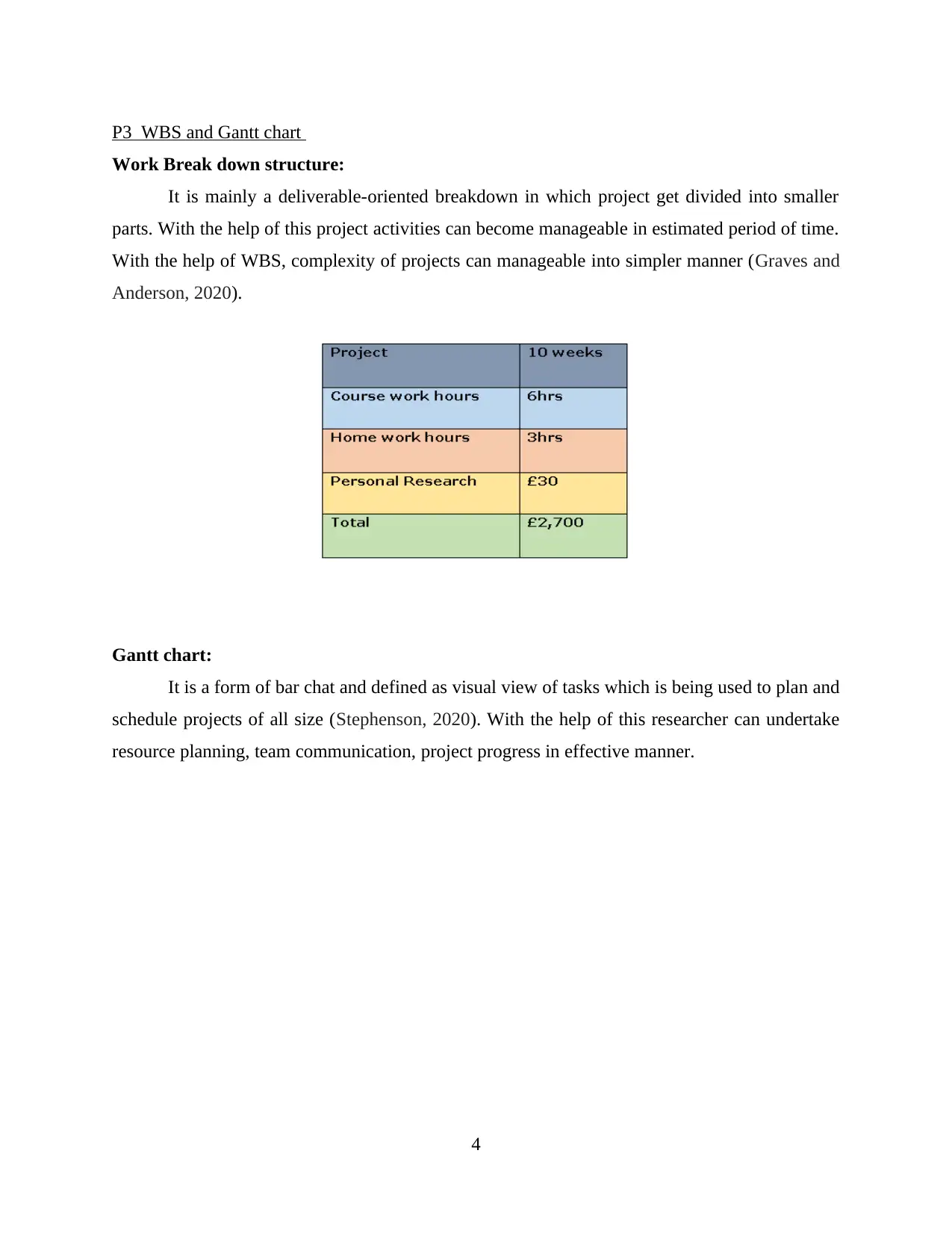
P3 WBS and Gantt chart
Work Break down structure:
It is mainly a deliverable-oriented breakdown in which project get divided into smaller
parts. With the help of this project activities can become manageable in estimated period of time.
With the help of WBS, complexity of projects can manageable into simpler manner (Graves and
Anderson, 2020).
Gantt chart:
It is a form of bar chat and defined as visual view of tasks which is being used to plan and
schedule projects of all size (Stephenson, 2020). With the help of this researcher can undertake
resource planning, team communication, project progress in effective manner.
4
Work Break down structure:
It is mainly a deliverable-oriented breakdown in which project get divided into smaller
parts. With the help of this project activities can become manageable in estimated period of time.
With the help of WBS, complexity of projects can manageable into simpler manner (Graves and
Anderson, 2020).
Gantt chart:
It is a form of bar chat and defined as visual view of tasks which is being used to plan and
schedule projects of all size (Stephenson, 2020). With the help of this researcher can undertake
resource planning, team communication, project progress in effective manner.
4
⊘ This is a preview!⊘
Do you want full access?
Subscribe today to unlock all pages.

Trusted by 1+ million students worldwide

P4 Carry out small-scale research applying primary and secondary methods appropriate for
meeting project aims and objectives
Primary research-
5
meeting project aims and objectives
Primary research-
5
Paraphrase This Document
Need a fresh take? Get an instant paraphrase of this document with our AI Paraphraser
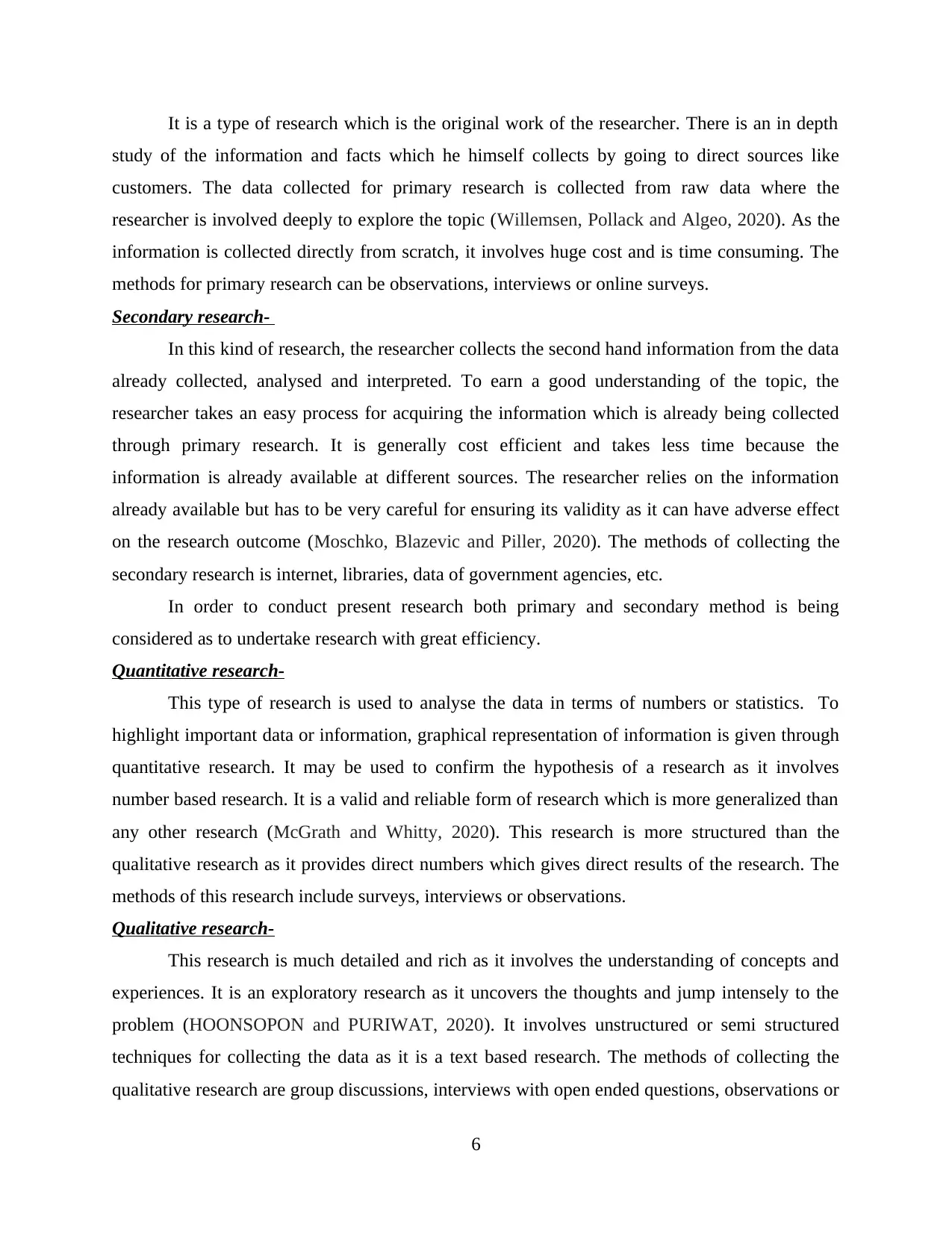
It is a type of research which is the original work of the researcher. There is an in depth
study of the information and facts which he himself collects by going to direct sources like
customers. The data collected for primary research is collected from raw data where the
researcher is involved deeply to explore the topic (Willemsen, Pollack and Algeo, 2020). As the
information is collected directly from scratch, it involves huge cost and is time consuming. The
methods for primary research can be observations, interviews or online surveys.
Secondary research-
In this kind of research, the researcher collects the second hand information from the data
already collected, analysed and interpreted. To earn a good understanding of the topic, the
researcher takes an easy process for acquiring the information which is already being collected
through primary research. It is generally cost efficient and takes less time because the
information is already available at different sources. The researcher relies on the information
already available but has to be very careful for ensuring its validity as it can have adverse effect
on the research outcome (Moschko, Blazevic and Piller, 2020). The methods of collecting the
secondary research is internet, libraries, data of government agencies, etc.
In order to conduct present research both primary and secondary method is being
considered as to undertake research with great efficiency.
Quantitative research-
This type of research is used to analyse the data in terms of numbers or statistics. To
highlight important data or information, graphical representation of information is given through
quantitative research. It may be used to confirm the hypothesis of a research as it involves
number based research. It is a valid and reliable form of research which is more generalized than
any other research (McGrath and Whitty, 2020). This research is more structured than the
qualitative research as it provides direct numbers which gives direct results of the research. The
methods of this research include surveys, interviews or observations.
Qualitative research-
This research is much detailed and rich as it involves the understanding of concepts and
experiences. It is an exploratory research as it uncovers the thoughts and jump intensely to the
problem (HOONSOPON and PURIWAT, 2020). It involves unstructured or semi structured
techniques for collecting the data as it is a text based research. The methods of collecting the
qualitative research are group discussions, interviews with open ended questions, observations or
6
study of the information and facts which he himself collects by going to direct sources like
customers. The data collected for primary research is collected from raw data where the
researcher is involved deeply to explore the topic (Willemsen, Pollack and Algeo, 2020). As the
information is collected directly from scratch, it involves huge cost and is time consuming. The
methods for primary research can be observations, interviews or online surveys.
Secondary research-
In this kind of research, the researcher collects the second hand information from the data
already collected, analysed and interpreted. To earn a good understanding of the topic, the
researcher takes an easy process for acquiring the information which is already being collected
through primary research. It is generally cost efficient and takes less time because the
information is already available at different sources. The researcher relies on the information
already available but has to be very careful for ensuring its validity as it can have adverse effect
on the research outcome (Moschko, Blazevic and Piller, 2020). The methods of collecting the
secondary research is internet, libraries, data of government agencies, etc.
In order to conduct present research both primary and secondary method is being
considered as to undertake research with great efficiency.
Quantitative research-
This type of research is used to analyse the data in terms of numbers or statistics. To
highlight important data or information, graphical representation of information is given through
quantitative research. It may be used to confirm the hypothesis of a research as it involves
number based research. It is a valid and reliable form of research which is more generalized than
any other research (McGrath and Whitty, 2020). This research is more structured than the
qualitative research as it provides direct numbers which gives direct results of the research. The
methods of this research include surveys, interviews or observations.
Qualitative research-
This research is much detailed and rich as it involves the understanding of concepts and
experiences. It is an exploratory research as it uncovers the thoughts and jump intensely to the
problem (HOONSOPON and PURIWAT, 2020). It involves unstructured or semi structured
techniques for collecting the data as it is a text based research. The methods of collecting the
qualitative research are group discussions, interviews with open ended questions, observations or
6
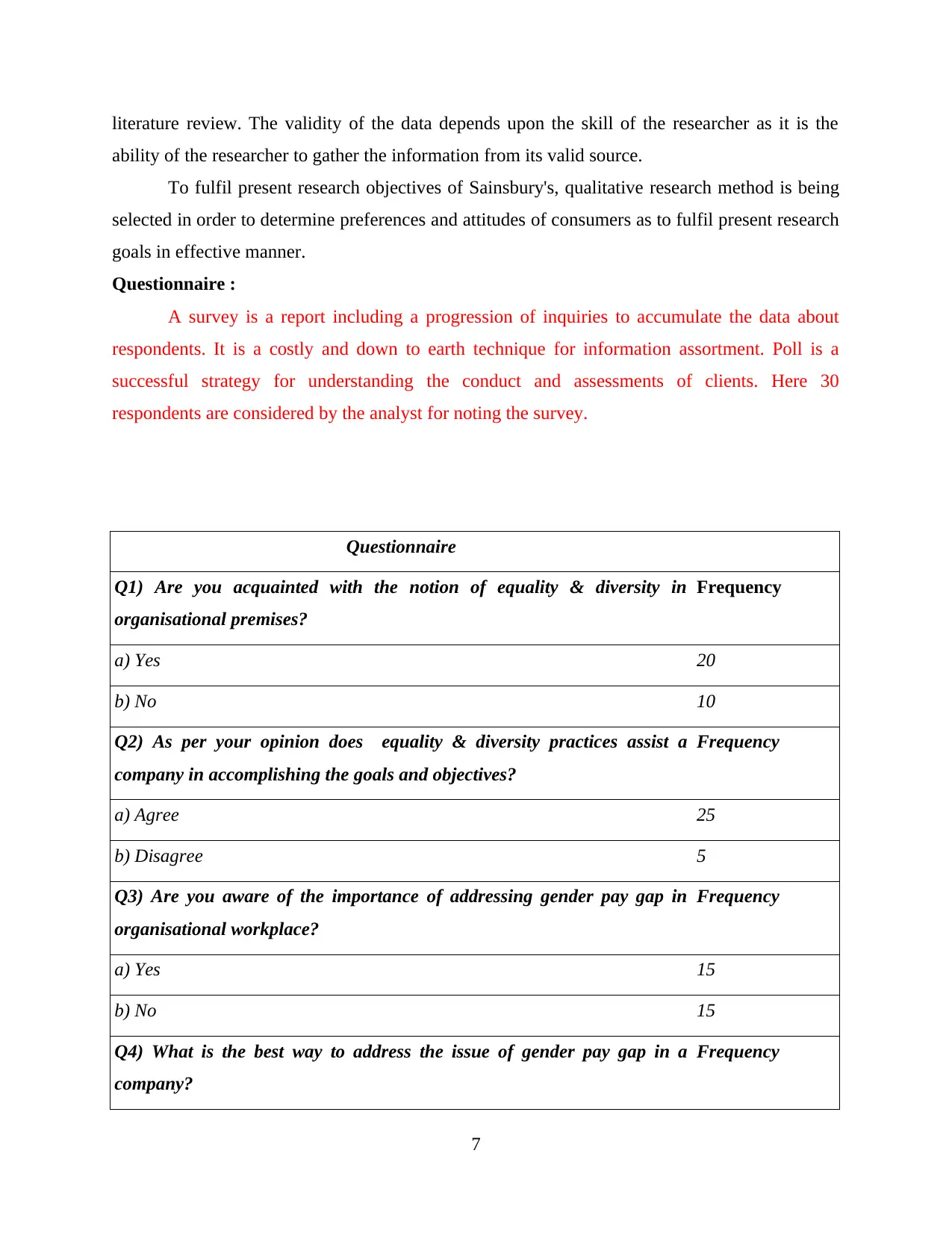
literature review. The validity of the data depends upon the skill of the researcher as it is the
ability of the researcher to gather the information from its valid source.
To fulfil present research objectives of Sainsbury's, qualitative research method is being
selected in order to determine preferences and attitudes of consumers as to fulfil present research
goals in effective manner.
Questionnaire :
A survey is a report including a progression of inquiries to accumulate the data about
respondents. It is a costly and down to earth technique for information assortment. Poll is a
successful strategy for understanding the conduct and assessments of clients. Here 30
respondents are considered by the analyst for noting the survey.
Questionnaire
Q1) Are you acquainted with the notion of equality & diversity in
organisational premises?
Frequency
a) Yes 20
b) No 10
Q2) As per your opinion does equality & diversity practices assist a
company in accomplishing the goals and objectives?
Frequency
a) Agree 25
b) Disagree 5
Q3) Are you aware of the importance of addressing gender pay gap in
organisational workplace?
Frequency
a) Yes 15
b) No 15
Q4) What is the best way to address the issue of gender pay gap in a
company?
Frequency
7
ability of the researcher to gather the information from its valid source.
To fulfil present research objectives of Sainsbury's, qualitative research method is being
selected in order to determine preferences and attitudes of consumers as to fulfil present research
goals in effective manner.
Questionnaire :
A survey is a report including a progression of inquiries to accumulate the data about
respondents. It is a costly and down to earth technique for information assortment. Poll is a
successful strategy for understanding the conduct and assessments of clients. Here 30
respondents are considered by the analyst for noting the survey.
Questionnaire
Q1) Are you acquainted with the notion of equality & diversity in
organisational premises?
Frequency
a) Yes 20
b) No 10
Q2) As per your opinion does equality & diversity practices assist a
company in accomplishing the goals and objectives?
Frequency
a) Agree 25
b) Disagree 5
Q3) Are you aware of the importance of addressing gender pay gap in
organisational workplace?
Frequency
a) Yes 15
b) No 15
Q4) What is the best way to address the issue of gender pay gap in a
company?
Frequency
7
⊘ This is a preview!⊘
Do you want full access?
Subscribe today to unlock all pages.

Trusted by 1+ million students worldwide
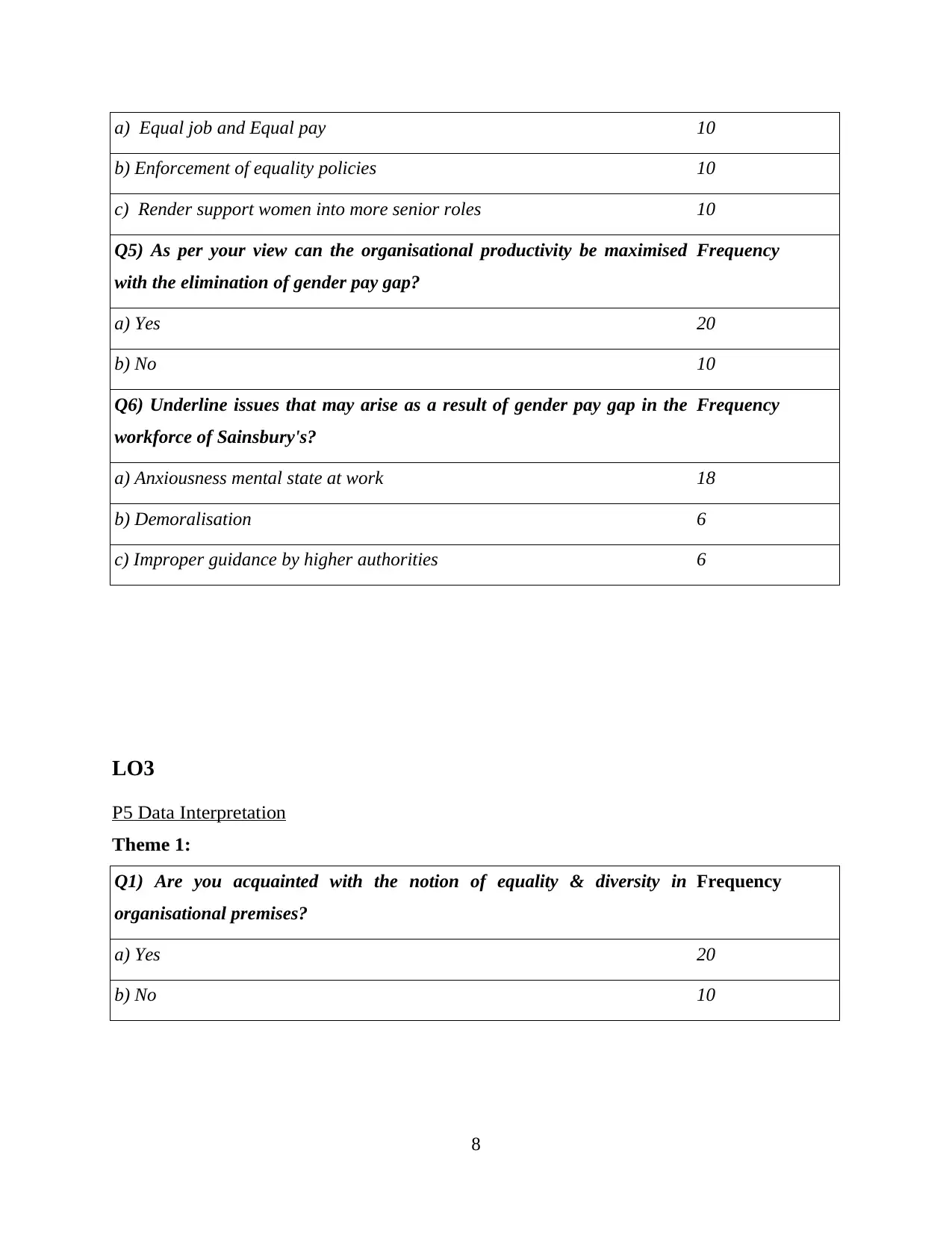
a) Equal job and Equal pay 10
b) Enforcement of equality policies 10
c) Render support women into more senior roles 10
Q5) As per your view can the organisational productivity be maximised
with the elimination of gender pay gap?
Frequency
a) Yes 20
b) No 10
Q6) Underline issues that may arise as a result of gender pay gap in the
workforce of Sainsbury's?
Frequency
a) Anxiousness mental state at work 18
b) Demoralisation 6
c) Improper guidance by higher authorities 6
LO3
P5 Data Interpretation
Theme 1:
Q1) Are you acquainted with the notion of equality & diversity in
organisational premises?
Frequency
a) Yes 20
b) No 10
8
b) Enforcement of equality policies 10
c) Render support women into more senior roles 10
Q5) As per your view can the organisational productivity be maximised
with the elimination of gender pay gap?
Frequency
a) Yes 20
b) No 10
Q6) Underline issues that may arise as a result of gender pay gap in the
workforce of Sainsbury's?
Frequency
a) Anxiousness mental state at work 18
b) Demoralisation 6
c) Improper guidance by higher authorities 6
LO3
P5 Data Interpretation
Theme 1:
Q1) Are you acquainted with the notion of equality & diversity in
organisational premises?
Frequency
a) Yes 20
b) No 10
8
Paraphrase This Document
Need a fresh take? Get an instant paraphrase of this document with our AI Paraphraser
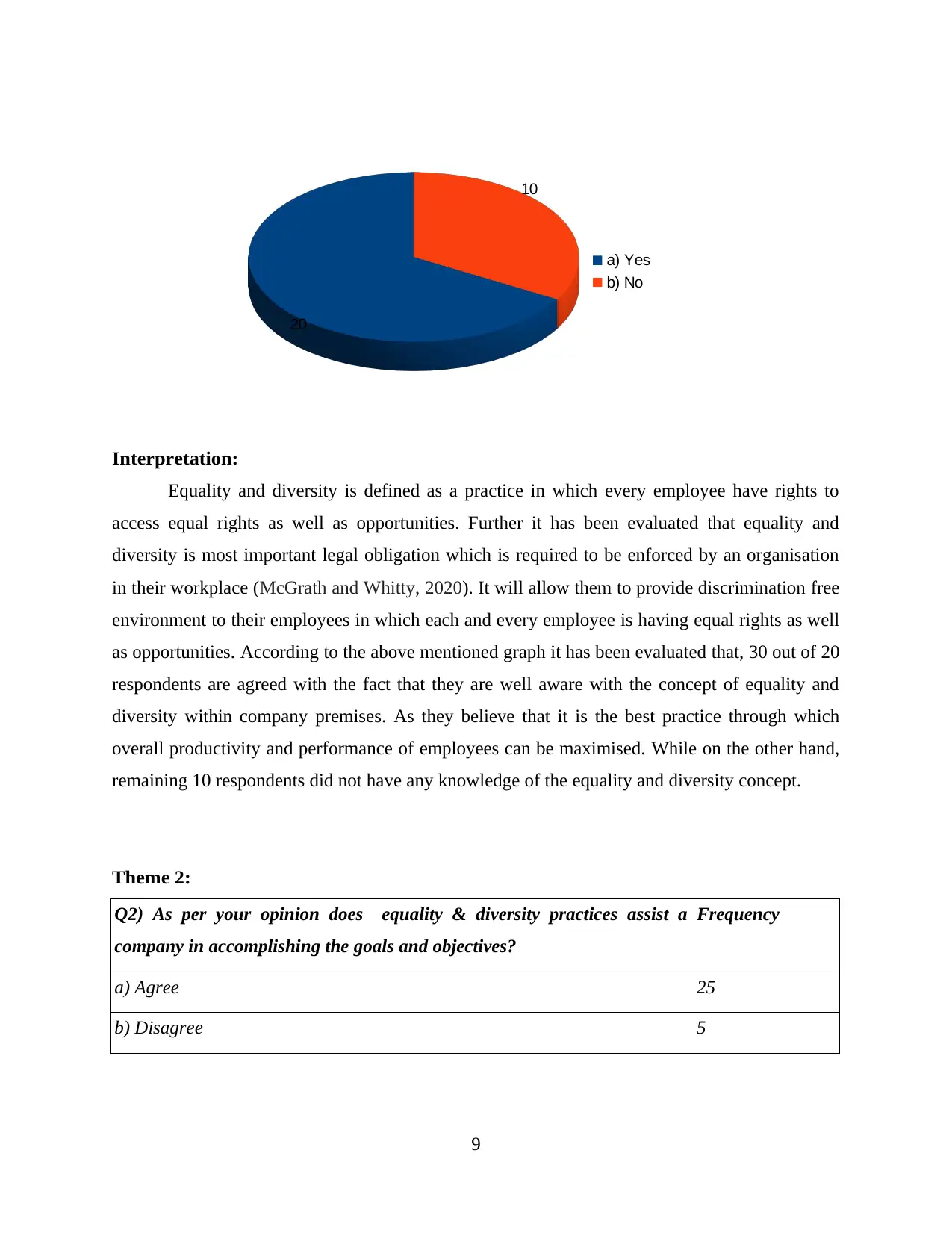
Interpretation:
Equality and diversity is defined as a practice in which every employee have rights to
access equal rights as well as opportunities. Further it has been evaluated that equality and
diversity is most important legal obligation which is required to be enforced by an organisation
in their workplace (McGrath and Whitty, 2020). It will allow them to provide discrimination free
environment to their employees in which each and every employee is having equal rights as well
as opportunities. According to the above mentioned graph it has been evaluated that, 30 out of 20
respondents are agreed with the fact that they are well aware with the concept of equality and
diversity within company premises. As they believe that it is the best practice through which
overall productivity and performance of employees can be maximised. While on the other hand,
remaining 10 respondents did not have any knowledge of the equality and diversity concept.
Theme 2:
Q2) As per your opinion does equality & diversity practices assist a
company in accomplishing the goals and objectives?
Frequency
a) Agree 25
b) Disagree 5
9
20
10
a) Yes
b) No
Equality and diversity is defined as a practice in which every employee have rights to
access equal rights as well as opportunities. Further it has been evaluated that equality and
diversity is most important legal obligation which is required to be enforced by an organisation
in their workplace (McGrath and Whitty, 2020). It will allow them to provide discrimination free
environment to their employees in which each and every employee is having equal rights as well
as opportunities. According to the above mentioned graph it has been evaluated that, 30 out of 20
respondents are agreed with the fact that they are well aware with the concept of equality and
diversity within company premises. As they believe that it is the best practice through which
overall productivity and performance of employees can be maximised. While on the other hand,
remaining 10 respondents did not have any knowledge of the equality and diversity concept.
Theme 2:
Q2) As per your opinion does equality & diversity practices assist a
company in accomplishing the goals and objectives?
Frequency
a) Agree 25
b) Disagree 5
9
20
10
a) Yes
b) No
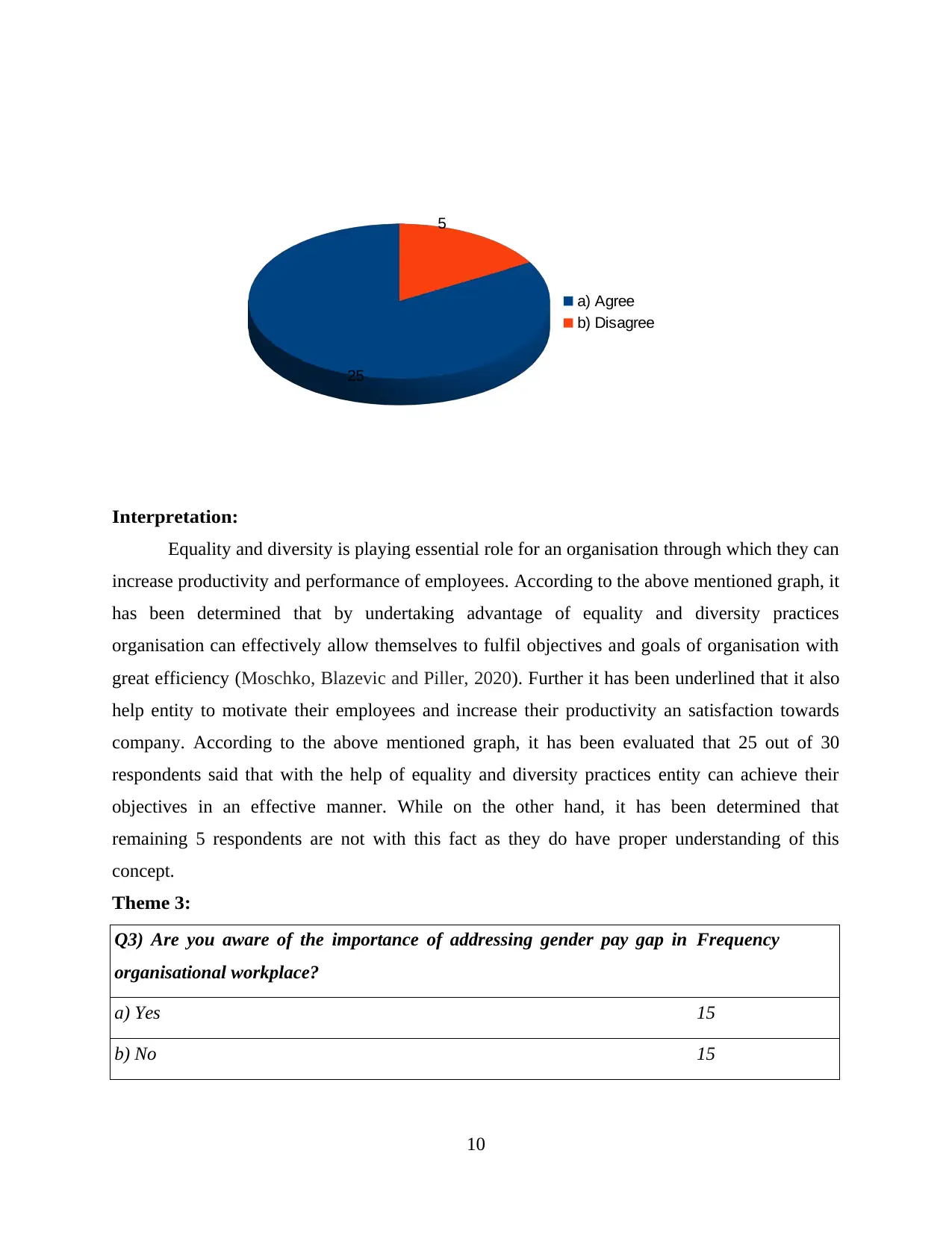
Interpretation:
Equality and diversity is playing essential role for an organisation through which they can
increase productivity and performance of employees. According to the above mentioned graph, it
has been determined that by undertaking advantage of equality and diversity practices
organisation can effectively allow themselves to fulfil objectives and goals of organisation with
great efficiency (Moschko, Blazevic and Piller, 2020). Further it has been underlined that it also
help entity to motivate their employees and increase their productivity an satisfaction towards
company. According to the above mentioned graph, it has been evaluated that 25 out of 30
respondents said that with the help of equality and diversity practices entity can achieve their
objectives in an effective manner. While on the other hand, it has been determined that
remaining 5 respondents are not with this fact as they do have proper understanding of this
concept.
Theme 3:
Q3) Are you aware of the importance of addressing gender pay gap in
organisational workplace?
Frequency
a) Yes 15
b) No 15
10
25
5
a) Agree
b) Disagree
Equality and diversity is playing essential role for an organisation through which they can
increase productivity and performance of employees. According to the above mentioned graph, it
has been determined that by undertaking advantage of equality and diversity practices
organisation can effectively allow themselves to fulfil objectives and goals of organisation with
great efficiency (Moschko, Blazevic and Piller, 2020). Further it has been underlined that it also
help entity to motivate their employees and increase their productivity an satisfaction towards
company. According to the above mentioned graph, it has been evaluated that 25 out of 30
respondents said that with the help of equality and diversity practices entity can achieve their
objectives in an effective manner. While on the other hand, it has been determined that
remaining 5 respondents are not with this fact as they do have proper understanding of this
concept.
Theme 3:
Q3) Are you aware of the importance of addressing gender pay gap in
organisational workplace?
Frequency
a) Yes 15
b) No 15
10
25
5
a) Agree
b) Disagree
⊘ This is a preview!⊘
Do you want full access?
Subscribe today to unlock all pages.

Trusted by 1+ million students worldwide
1 out of 23
Related Documents
Your All-in-One AI-Powered Toolkit for Academic Success.
+13062052269
info@desklib.com
Available 24*7 on WhatsApp / Email
![[object Object]](/_next/static/media/star-bottom.7253800d.svg)
Unlock your academic potential
Copyright © 2020–2025 A2Z Services. All Rights Reserved. Developed and managed by ZUCOL.





